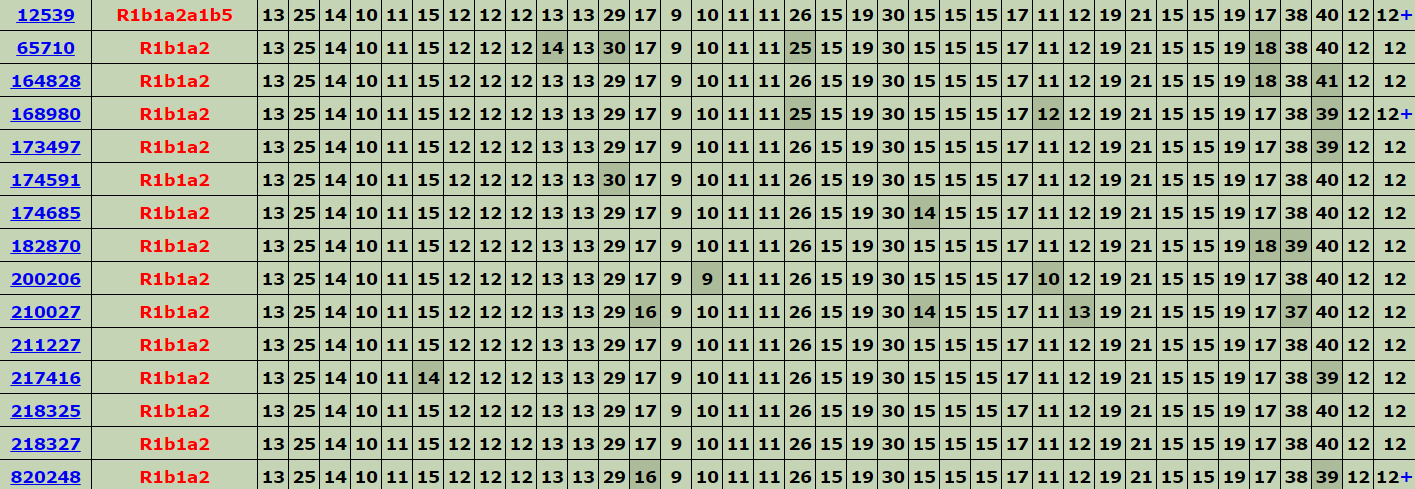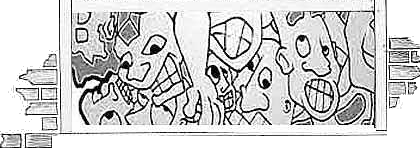(click on numbered dot to show name)
"New England and New York" by John Seller, 1703 (source: Norman B Leventhal Map Center)
(click on name to scroll to relevant section)
Introduction
This article represents a survey of DNA evidence for various Baker families who settled New England. The timeframe includes Bakers born from roughly 1600 and 1700. Let me start with this disclaimer: this article focuses solely on American male ancestors. Not trying to be sexist here, but Y-DNA passes from male to male through the Y chromosome. It is by definition “patrilineal”. In addition, our surname historically passes from our father. Given America’s relatively short European history, we all have one unique patrilineal progenitor who first set foot in the US (with the obvious exception of Native Americans). Let me refer to this first male immigrant as a “founder”. My founding ancestor is Max Schwartz who arrived from Poland/Russia around 1875. My mother’s founding ancestor is William Baker who arrived in Concord MA around 1660.
Genealogists have spent a huge amount of effort researching our founders. Now we can add DNA to the mix. While autosomal DNA does not work here because we are looking back too many generation, Y-DNA proves to be incredibly useful. The Bakerdna.net website has large number of people with the Baker surname who have tested. Basically, they seem to fall into three categories. First, there are the southern Bakers where the written records are thin. I do not envy their difficult research task. Y-DNA has proven critical to sort the various families. Second, there are the mid Atlantic Bakers of New Jersey, Pennsylvania, Maryland. Many of these Bakers arrived later, and one sees much more German influence where a surname like “Becker” gets changed after arrival. This article focuses on the the third group: the New England Bakers who began arriving as Puritans to Massachusetts in the “Great Migration” of 1620-1640. They left behind a rich collection of written records which have been summarized into some important sources:
- “The Great Migration Begins: Immigrants to New England 1620–1633”, 1996 and “The Great Migration: Immigrants to New England 1634–1635″ both by Robert Charles Anderson. These volumes represent the gold standard of Puritan immigration. They are flagship works of the New England Historical Genealogy Society (americanancestors.com)
- “A Genealogical Dictionary of the First Settlers of New England, Showing Three Generations of Those Who Came Before May, 1692, on the Basis of Farmer’s Register” by James Savage, 1862. : Less accurate, but has a wider scope than “The Great Migration” volumes. Savage writes brief accounts like he is texting someone. The biographies can be hard to decipher, but they get to the point.
- FamilySearch and Wikitree – both provide grand unified trees. Sourcing information can be hit-and-miss. Some discussions are excellent. It depends on the manager.
- Old Family Histories – these are the collection of books that were largely self-published starting in the latter part of the 1800’s. Most lack sources, but the authors clearly spent a lot of effort publishing an accurate account. Many are available on-line for viewing
The submitters of Y-DNA usually provide a branch to show their relationship to their Baker founder. I have a lot of confidence in these branches because these individuals invested a lot of time/money to submit Y-DNA samples. These branches have been combined to form the Y-DNA trees below. There is little attempt to resolve any inconsistences in any research.
Finally, you must be very careful how you interpret the DNA results. For example, my cousin’s Y-DNA matches another tester with common ancestor Peter Baker. The DNA shows that this Baker line is not related to other New England lines. The DNA does nothing to show that Peter is a descendant of William Baker.

Not listed on “The Great Migration Begins”
Familysearch Link: click here
Wikitree Link: click here
“Genealogy of the Descendants of Edward Baker of Lynn, Mass, 1630” by Nelson M Baker, 1867. click here
from Savage:EDWARD, Lynn 1630, freem. 14 Mar. 1638, had w. Jane, certain. five s. perhaps other ch. beside d. Mary, wh. m. 7 Nov. 1662, George Sumner of Dorchester, hav. foll. her to Northampton where B. liv. many yrs. Leav. s. Joseph and Timothy at N. whose names are misprint. Batter in Geneal. Reg. IX. 88; he went back to L. there d. Mar. 1687, giv. est. to s. John of Dedham, Edward, and Thomas, of Lynn.

Not listed on “The Great Migration Begins”
Familysearch Link: click here
Wikitree Link: click here
From SavageTHOMAS, Roxbury, s. of John the first of Ipswich, freem. 1619, by w. Elizabeth had Elizabeth b. 2 Oct. 1641; John; Joseph, 24, bapt. 27 Feb. 1648; Sarah, 24, bapt. 28 Apr. 1650; Mary, bapt. 6 June 1652, d. in 5 weeks; Mary, again, 11 Sept. 1653; and for sec. w. took 27 Mar. or May 1663, Mary, d. of Robert Gamlin, had Thomas, b. 7 Jan. 1664; and Mary, 27 July 1667; and he d. 28 Jan. 1684, “old, blind, godly,” in the express. rec. of ch. His s. Thomas was k. by the Ind. at Sudbury fight Apr. 1676, surely a very young soldier, under Wadsworth, but he had serv. in the Narraganset campaign as one of Johnson’s comp. in Dec. bef. i. e. less than twelve yrs. old. No incid. of those days more striking. gives proof of the extens. reach of the perils. Sarah m. 19 Apr. 1671, Sebas Jackson; and Mary m. Roger Adams.

Listed on “The Great Migration” (Vol. 1, page 130)
Familysearch Link: click here
Wikitree Link: click here
From Savage:ALEXANDER, Boston, ropemaker, came in the Elizabeth and Ann, 1635, aged 28, from London, with w. Elizabeth 23; and ch. Elizabeth 3; and Christian, 1; had Alexander, b. 15 Jan. 1636; Samuel, 16 Jan. 1638; John, 20 June 1640; Joshua, 30 Apr. 1642; Hannah, 29 Sept. 1644; all bapt. 5 Oct. 1645, as he and his w. were adm. of the ch. the preced. day, was freem. 1646; had, also, William, 15 May 1647; Benjamin, 16 Mar. 1653; Josiah, 26 Feb. 1655; and Josiah, again, 26 Feb. 1658, if we accept the rec. Not one of the four last were bapt. in first ch. wh. may provoke inq. for the reason. At Gloucester he had sat down on first coming; and in the gr. to Rev. Richard Blinman, 1642, the same ld. is giv. that had bef. been offer. to Alexander B. His d. Christina m. 18 July 1654 Simon Roberts.

Listed in “The Great Migration” (Vol. 1, page 132)
Familysearch Link: click here
Wikitree Link: click here
from Savage:FRANCIS, Boston, came in the Planter, 1635, aged 24, m. 1641, Isabel Twining, perhaps d. of William, had Nathaniel, b. 27 Mar. 1642; rem. to Yarmouth, and there had John; Samuel, 1 May 1648; Daniel, 2 Sept. 1650; William; Thomas; Elizabeth wh. m. John Chase; and Hannah, wh. m. a Pierce, and he d. 1696, in 85th yr. In his will of 4 Mar. 1693, as all these ch. but Samuel are nam. it may be thot. that he was d. His wid. d. 16 May 1706

Listed on “The Great Migration Begins” (Vol. 1, page 139)
Familysearch Link: click here
Wikitree Link: click here
from Savage:NICHOLAS, Hingham 1635, br. of the first Nathaniel, freem. 3 Mar. 1636, rep. 1636 and 8, rem. to Scituate, there was ord. 1660, third min. of the first ch. and was of such good temper as to reconcile the two chs. wh. had quarrel. for thirty yrs. He had Samuel, bapt. 7 Oct. 1638; John, 6 Nov. 1642; Elizabeth Nov. 1644; and Deborah, 6 June 1652. Mather, with his habitual carelessness, says, in the Magn. III. 219, “he had but a private educat.” taking occasion to utter one of his brilliant clauses; yet I found at St. John’s Coll. Cambr. that he had his A. B. 1631-2, and A. M. 1635. A short time he stopped at Roxbury. His w. that prob. was mo. of all his ch. d. 4 Apr. 1661, and he next yr. took ano. of wh. the bapt. name Grace only is kn. and d. 22 Aug. 1678, aged 67. Her he made Extrix. of his will, in wh. he names six ch. Samuel, Nicholas, Elizabeth Sarah, Deborah, and Mary. The wid. Grace d. 22 Jan. 1697. All the ds. were m. Mary, 26 Feb. 1662, to Stephen Vinal; Elizabeth m. 1664 to John Vinal; Sarah m. 1671, Josiah Litchfield; and Deborah m. 1678, Israel Chittenden. Deane, 181-3.

Not listed on “The Great Migration”
Familysearch Link: click here
Wikitree Link: click here
from Savage (note: Cornelius likely a son of Robert )ROBERT, Salem, wh. had gr. of ld. 1637, was k. by casualty 1640. See Winthrop II. 24.
CORNELIUS, Salem, m. 26 Apr. 1658, Hannah, d. of John Woodbury, had Hannah, b. 14 Oct. 1660, d. at 2 yrs. Hannah, again, 28 Nov. 1662; liv. on Beverly side 1671-86

Arrived too late to be listed on “The Great Migration Begins”
Familysearch Link: click here
Wikitree Link: click here
from Savage:THOMAS, a min. 1678 at Newport, I hear nothing, more of.

Comment: DNA results for my Baker line
Familysearch Link: click here
Wikitree Link: click here
Not listed on Savage.
“Genealogy and history of the Baker, Andrus, Clark, and Adams families” by Albert Clark Baker, 1920. click here.
Wikitree Link: click here
from Savage:
JOHN, Hartford, was there as early as 1665, m. Lydia, d. of John Baysey, had John, Baysey, and Joseph, all s. and perhaps other ch. His w. d. 16 May 1700.

Familysearch Link: click here
Wikitree Link: click here
From Savage:SAMUEL, Marshfield, not s. of Nicholas, as was once thot. m. 29 Dec. 1656, Elinor, d. of Kenelm Winslow, had Kenelm, b. 23 Mar. 1658, Lydia, 18 Feb. 1660; Elizabeth 18 Mar. 1662; Alice, 19 May 1663; and Elinor; 1665; beside others in 1667, 9, and 71, of whose names, in the mutilat. state of the rec. no certainty can be attain. His w. d. or was bur. 27 Aug. 1676, and he m. 21 Feb. foll. Patience, wid. perhaps of the first Moses Simmons of Duxbury, had Samuel.

Familysearch Link: click here
Wikitree Link: click here

Comment:
Most sites link this Thomas Baker with #4 Francis Baker of Yarmouth. However, these two test takers do not match. The branch from Francis and Thomas to the present time is long with many possible explanations.
Familysearch Link: click here
Wikitree Link: click here

Comment:
There are three Bakers in group 5a from New England. Published trees trace them back to either Francis Baker or Alexander Baker, both of whom are claimed above. Therefore we have an unknown Baker ancestor. Kits 208272 and N3156 seem to intersect in Woodbury CT. Articles have been written about multiple John Bakers living in the area at this time.
